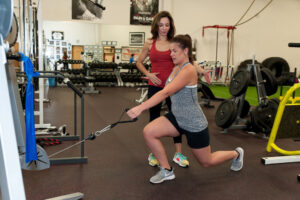

Those conditions make it a good time to think about next season and what can you do to improve your golf game before you tee it up again.
This post is the first of four about what you can do to from an exercise perspective to improve your game in the off season. It’s based on research that confirms what you should focus on with a trainer, when at your gym or in your home exercise area this winter.
Better golfers, as one leading study I found says “possess unique physical characteristics that are important to greater proficiency. These characteristics have also been demonstrated to be modifiable through golf-specific training programs.”
What are those characteristics? “Significantly greater hip strength, torso strength, shoulder strength, shoulder flexibility, hip flexibility, torso flexibility, and balance (eyes open),” the study says. And the training you can do to address them is not rigorous. It just needs to be what will make a difference to your golf swing and done consistently.
Let’s review each physical characteristic that separates the average from better women golfers. In subsequent posts early next year I will then give you links, tips and video with experts, plus publications to address each. Those posts will keep things simple— suggesting 3-4 moves you can employ to address each characteristic.
Strength

“Our research has demonstrated that there is a relationship between maximum torso velocity (during the downswing) and ball velocity.” Higher ball velocity = greater driving distance. And, as I have written many times before, all of the data shows greater driving distance reduces your score. In short, if you can get a bit stronger this winter you will hit your drives a bit farther in the spring.
Flexibility
“During an efficient and effective golf swing, individuals attain positions that require good flexibility,” the study says.

I will have some specific stretches for you in a later post designed to help you more easily create or improve your X factor.
Balance

Better players have better single-leg balance with their eyes open, according to numerous studies and data from the Titleist Performance Institute. This video shows the problems— swaying and chunking are among them— that balance issues cause. It also shows you how to self-test your balance against what is considered optimal for good golf.
I’m off to shoot video and meet with a Titleist Performance Institute certified trainer now to begin my follow-up series of posts.
The study I based this post on is from The Journal of Strength and Conditioning Research entitled
STRENGTH, FLEXIBILITY, AND BALANCE CHARACTERISTICS OF HIGHLY PROFICIENT GOLFERS



